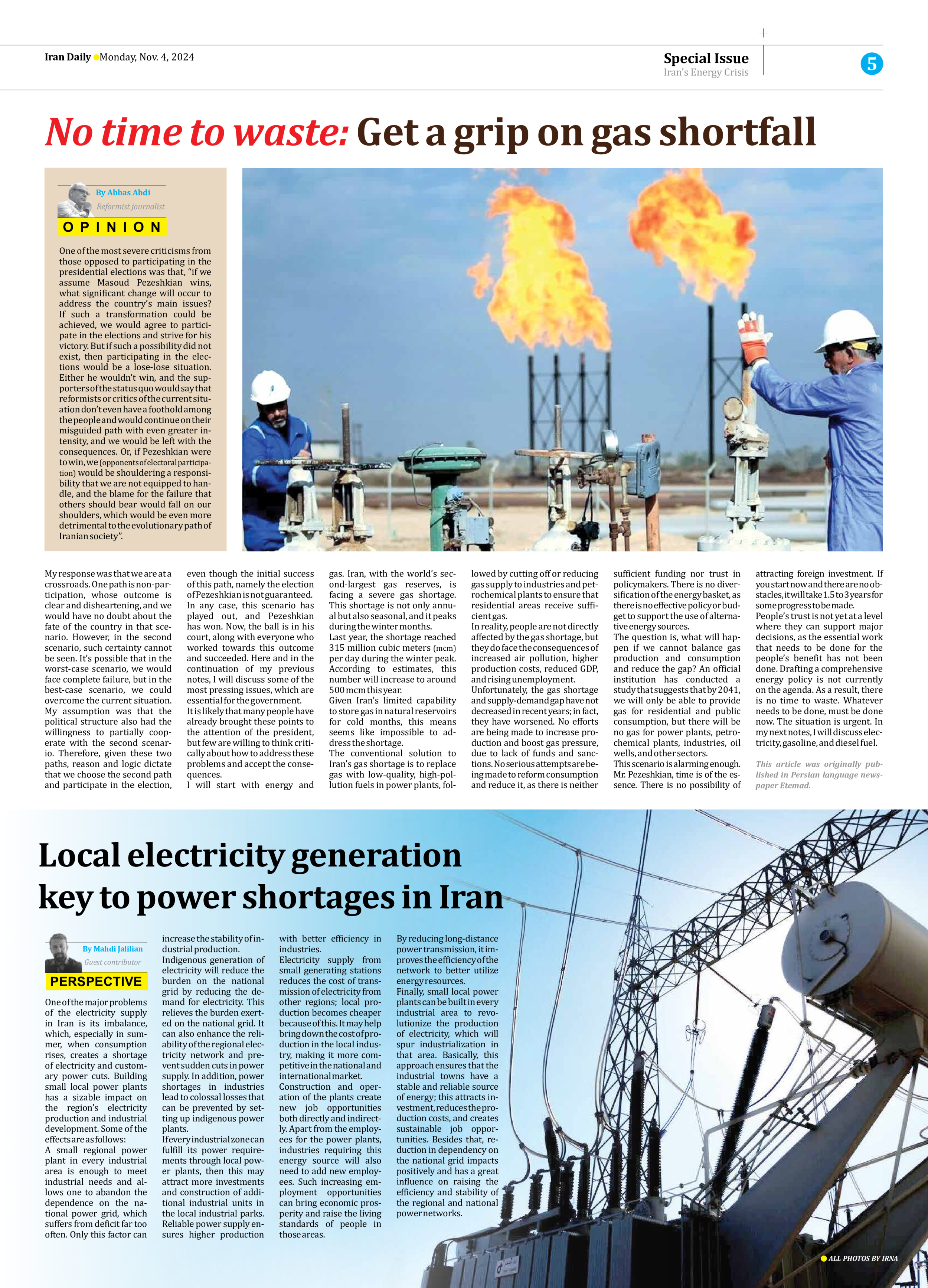
No time to waste: Get a grip on gas shortfall
One of the most severe criticisms from those opposed to participating in the presidential elections was that, “if we assume Masoud Pezeshkian wins, what significant change will occur to address the country’s main issues? If such a transformation could be achieved, we would agree to participate in the elections and strive for his victory. But if such a possibility did not exist, then participating in the elections would be a lose-lose situation. Either he wouldn’t win, and the supporters of the status quo would say that reformists or critics of the current situation don’t even have a foothold among the people and would continue on their misguided path with even greater intensity, and we would be left with the consequences. Or, if Pezeshkian were to win, we (opponents of electoral participation) would be shouldering a responsibility that we are not equipped to handle, and the blame for the failure that others should bear would fall on our shoulders, which would be even more detrimental to the evolutionary path of Iranian society”.
By Abbas Abdi
Reformist journalist
My response was that we are at a crossroads. One path is non-participation, whose outcome is clear and disheartening, and we would have no doubt about the fate of the country in that scenario. However, in the second scenario, such certainty cannot be seen. It’s possible that in the worst-case scenario, we would face complete failure, but in the best-case scenario, we could overcome the current situation. My assumption was that the political structure also had the willingness to partially cooperate with the second scenario. Therefore, given these two paths, reason and logic dictate that we choose the second path and participate in the election, even though the initial success of this path, namely the election of Pezeshkian is not guaranteed.
In any case, this scenario has played out, and Pezeshkian has won. Now, the ball is in his court, along with everyone who worked towards this outcome and succeeded. Here and in the continuation of my previous notes, I will discuss some of the most pressing issues, which are essential for the government.
It is likely that many people have already brought these points to the attention of the president, but few are willing to think critically about how to address these problems and accept the consequences.
I will start with energy and gas. Iran, with the world’s second-largest gas reserves, is facing a severe gas shortage. This shortage is not only annual but also seasonal, and it peaks during the winter months.
Last year, the shortage reached 315 million cubic meters (mcm) per day during the winter peak. According to estimates, this number will increase to around 500 mcm this year.
Given Iran’s limited capability to store gas in natural reservoirs for cold months, this means seems like impossible to address the shortage.
The conventional solution to Iran’s gas shortage is to replace gas with low-quality, high-pollution fuels in power plants, followed by cutting off or reducing gas supply to industries and petrochemical plants to ensure that residential areas receive sufficient gas.
In reality, people are not directly affected by the gas shortage, but they do face the consequences of increased air pollution, higher production costs, reduced GDP, and rising unemployment.
Unfortunately, the gas shortage and supply-demand gap have not decreased in recent years; in fact, they have worsened. No efforts are being made to increase production and boost gas pressure, due to lack of funds and sanctions. No serious attempts are being made to reform consumption and reduce it, as there is neither sufficient funding nor trust in policymakers. There is no diversification of the energy basket, as there is no effective policy or budget to support the use of alternative energy sources.
The question is, what will happen if we cannot balance gas production and consumption and reduce the gap? An official institution has conducted a study that suggests that by 2041, we will only be able to provide gas for residential and public consumption, but there will be no gas for power plants, petrochemical plants, industries, oil wells, and other sectors.
This scenario is alarming enough. Mr. Pezeshkian, time is of the essence. There is no possibility of attracting foreign investment. If you start now and there are no obstacles, it will take 1.5 to 3 years for some progress to be made.
People’s trust is not yet at a level where they can support major decisions, as the essential work that needs to be done for the people’s benefit has not been done. Drafting a comprehensive energy policy is not currently on the agenda. As a result, there is no time to waste. Whatever needs to be done, must be done now. The situation is urgent. In my next notes, I will discuss electricity, gasoline, and diesel fuel.
This article was originally published in Persian language newspaper Etemad.







